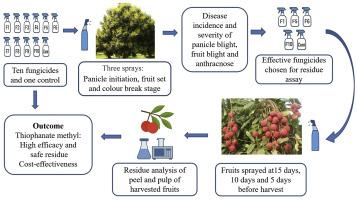杀菌剂防治荔枝穗疫病、果实疫病和炭疽病的功效、成本效益和残留水平
IF 2.5
2区 农林科学
Q1 AGRONOMY
引用次数: 0
摘要
荔枝受多种病害的影响,其中穗疫病、果实疫病和炭疽病是影响果实产量和品质的主要病害。使用杀菌剂是控制这些疾病的主要方法。在2022-2024年期间,在印度比哈尔邦的Muzaffarpur进行了研究,以评估十种杀菌剂的有效性,包括氮嘧菌酯、三氯虫酯、吡氯菌酯、异丙康唑、戊唑唑、甲基硫代酸盐、咪唑仑、多菌灵、代森锰锌和氯化铜以及各种组合。并分析了选定杀菌剂的残留水平是否符合安全标准。这些杀菌剂按每升水0.3至2.0克或毫升的推荐用量在荔枝树上施用三次,第一次在穗形成后施用,第二次在坐果后立即施用,第三次在变色期施用。杀菌剂残留测定是在“计划试验”中进行的,也在印度比哈尔邦Muzaffarpur和Patna地区的一些“随机零售样本”中进行的。结果表明,施用杀菌剂可显著降低荔枝穗枯病、果实枯病和炭疽病的发病率和严重程度,从而保护荔枝的穗和果实。发现甲基硫代盐最有效,2022年和2023年疾病严重程度指数的最小百分比分别为5.93和7.81。两年间,经甲基硫磷处理的果树果实枯萎病和炭疽病的发病率最低(0 - 0.50%),而对照果树果实枯萎病和炭疽病的发病率分别为5.50 - 8.50%和5.83 - 6.37%。氮氧嘧菌酯与甲基硫代菌酯的疾病控制效果在统计学上相当。噻吩酸甲酯对多种病害的综合防治效果最好,其增量成本效益比最高(5.52 ~ 5.63)。杀菌剂残留主要集中在果皮中,纸浆中仅检出氯化氧铜和多菌灵;所有情况下的残留水平都远低于FSSAI、EFSA和食品法典标准规定的最大残留限量(MRLs)。在采收前15天、10天和5天,喷施甲基硫虫酸酯、异虫唑、唑虫酯和未处理的果树(对照)果实样品中荔枝果肉残留量均低于定量限(0.01 mg/kg)。噻吩酸甲酯和异丙唑的残留量低于最大残留限量,氮嘧菌酯的残留量低于最大残留限量。研究结果对防治荔枝穗疫病、果实疫病和炭疽病的喷雾调度具有一定的指导意义。本文章由计算机程序翻译,如有差异,请以英文原文为准。

Efficacy, cost-effectiveness, and residue levels of fungicides for managing panicle blight, fruit blight and anthracnose diseases of litchi
Litchi is affected by several diseases among which panicle blight, fruit blight and anthracnose are major diseases that affect yield and quality of fruits. Use of fungicides are the primary method for managing these diseases. Studies were conducted at Muzaffarpur in Bihar state of India during during 2022–2024 to assess the effectiveness of ten fungicides, including azoxystrobin, trifloxystrobin, pyraclostrobin, difenoconazole, tebuconazole, thiophanate methyl, metiram, carbendazim, mancozeb, and copper oxychloride, and various combinations. Residue levels of selected fungicides were also analyzed for safety standards compliance. The fungicides were applied at recommended dosages ranging from 0.3 to 2.0 g or ml per litre of water on litchi trees thrice-first after panicle initiation, second immediately after fruit set, and third at colour-break stage. Fungicides residue assay was carried out in a ‘planned experiment,’ and also in some ‘random retail samples’ from Muzaffarpur and Patna districts of Bihar, India. The results showed that fungicide application significantly reduced the incidence and severity of panicle blight, fruit blights, and anthracnose, thereby protecting both panicles and developing fruits in litchi trees. Thiophanate methyl was found to be the most effective, with a minimum percent disease severity index of 5.93 in 2022 and 7.81 in 2023. Thiophanate methyl-treated trees recorded the lowest incidence of fruit blight and anthracnose (0.0–0.50 %) during both years, compared to significantly higher levels in control trees (5.50–8.50 % fruit blight and 5.83–6.37 % anthracnose). Azoxystrobin was statistically at par with thiophanate methyl in disease control efficacy. Thiophanate methyl had the highest overall disease control and recorded the highest incremental cost benefit ratio (5.52–5.63) for the complete spray schedule targeting multiple diseases. Fungicide residues were mainly confined to peels, with only copper oxychloride and carbendazim detected in pulp; residue levels in all cases remained well below the maximum residue limits (MRLs) established by FSSAI, EFSA, and Codex standards. Residues in litchi pulp from fruit samples of trees sprayed with thiophanate methyl, difenoconazole, azoxystrobin, and untreated trees (control), applied 15 days, 10 days, and 5-days before harvesting of fruits were found below limit of quantification (0.01 mg/kg). The residue level was below MRL for thiophanate methyl and difenoconazole but not for azoxystrobin. Results of the studies will be useful for spray scheduling to manage panicle blight, fruit blight and anthracnose of litchi.
求助全文
通过发布文献求助,成功后即可免费获取论文全文。
去求助
来源期刊

Crop Protection
农林科学-农艺学
CiteScore
6.10
自引率
3.60%
发文量
200
审稿时长
29 days
期刊介绍:
The Editors of Crop Protection especially welcome papers describing an interdisciplinary approach showing how different control strategies can be integrated into practical pest management programs, covering high and low input agricultural systems worldwide. Crop Protection particularly emphasizes the practical aspects of control in the field and for protected crops, and includes work which may lead in the near future to more effective control. The journal does not duplicate the many existing excellent biological science journals, which deal mainly with the more fundamental aspects of plant pathology, applied zoology and weed science. Crop Protection covers all practical aspects of pest, disease and weed control, including the following topics:
-Abiotic damage-
Agronomic control methods-
Assessment of pest and disease damage-
Molecular methods for the detection and assessment of pests and diseases-
Biological control-
Biorational pesticides-
Control of animal pests of world crops-
Control of diseases of crop plants caused by microorganisms-
Control of weeds and integrated management-
Economic considerations-
Effects of plant growth regulators-
Environmental benefits of reduced pesticide use-
Environmental effects of pesticides-
Epidemiology of pests and diseases in relation to control-
GM Crops, and genetic engineering applications-
Importance and control of postharvest crop losses-
Integrated control-
Interrelationships and compatibility among different control strategies-
Invasive species as they relate to implications for crop protection-
Pesticide application methods-
Pest management-
Phytobiomes for pest and disease control-
Resistance management-
Sampling and monitoring schemes for diseases, nematodes, pests and weeds.
 求助内容:
求助内容: 应助结果提醒方式:
应助结果提醒方式:


